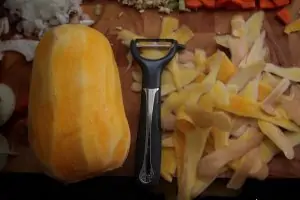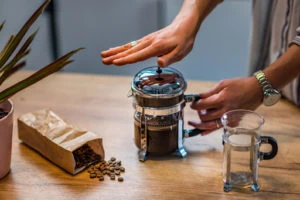
Butternut squash is a favorite vegetable, especially for the colder months. It’s an amazingly versatile component suitable for a wide variety of dishes in numerous types of cuisine. With its sweet and nutty flavor, you’ll find this tasty squash in dishes across the world of cooking, from Italian to Japanese.
The peeler du jour? I like the UberChef Premium Peeler at Amazon.
The steel blade of a hand-held peeler is slotted, with 1 side of the slot sharp enough to cut into the skin from potatoes and other vegetables and fruit, and another side that is dull or rounded to prevent the sharp side from plunging deeper into the rest of the vegetable or fruit.
One pro tip! No matter what peeler you use, a good way to make the butternut squash peeling process a little easier is to poke holes in the squash and microwave it for 1-3 minutes before starting the peeling process, allowing the heat to soften and loosen the skin.
Are you hankering for a snack? Just like with pumpkins, you can roast and eat the seeds of a butternut squash for a dose of healthy oils and extra fiber.
The most common herbs and spices used with butternut squash are nutmeg, cinnamon, star anise, oregano, thyme, garlic, rosemary, black pepper, and allspice.
| Best Vegetable Peeler for Butternut Squash | Why We Like It |
|---|---|
| 1. OXO Good Grips Pro Y-Peeler | secure, non-slip grip |
| 2. Victorinox Swiss Army Peeler | sleek, simple and efficient |
| 3. Victorinox 7.6074 Kitchen Vegetable Peeler | good for people with arthritis |
| 4. Victorinox Swiss Fruit & Vegetable Peeler | high quality |
| 5. OXO Good Grips Y Peeler | low-cost, simple option |
| 6. Tagefa Potato Peeler Y Shaped Vegetable Peeler | durable handle and sharp, hard blade |
| 7. i Kito 2 in 1 Stainless Steel Tomato Peeler Multifunctional | made of stainless steel |
| 8. Vremi 3 in 1 Julienne Vegetable Peeler | 3 rotating serrated stainless steel blades |
| 9. UberChef Erg Premium Ultra Sharp Julienne Peeler | dishwasher safe and comes with a cleaning brush |
Peel Perfect
Unless you’re simply cutting the squash in half and roasting it in the oven (also delicious!), you’re going to have to peel away the tough outer skin and cube, slice, or scoop out the softer, fleshy part on the inside of the butternut squash to add it into soups, pasta, salads, or sautéed it on its own.
Although technically any old knife can do what a peeler does, the difference between the 2 when it comes to preparing your favorite fruits and vegetables for frying, baking, or raw consumption is that even the most basic peeler is better equipped to get the job done.
A “Y” peeler, with a blade set perpendicular to the handle, facilitates a smooth, slicing away of the skin, and is one of the best models to use.

What to do about that skin?
Butternut squash has a thick and fibrous skin. While this beige skin is technically edible (after cooking), it is quite chewy and tough. Along with the seeds and the stalk, it’s standard practice to discard the skin before cooking, unless you’re roasting it.
Unlike many vegetables, peeling a butternut squash doesn’t greatly diminish its nutritional value. So, what’s the best peeler for butternut squash?
Considerations when choosing a peeler
There are a few important things to consider when choosing a peeler for butternut squash. It may not be as simple and straightforward as you might think!
- Price: isn’t as important as many believe. You can find a great quality peeler for hard and tough vegetables, like those in the squash family, at a range of different prices. That’s great news for those of us on a budget because there are many reasonably-priced peelers.
- Blade Material: The most important feature is the blade itself. It needs to be made from quality steel. I don’t recommend trying to use a flimsy plastic peeler. It could easily break and cause injury. High-quality stainless steel or carbon steel are the best options here, although there are ceramic and “super plastic” blades out there.
- Pivot Mechanism: It’s also important to look for a peeler with a movable blade. Additionally, the peeler needs to be sharp. It needs to stay sharp, as it’s essentially impossible to sharpen the blades.
- Ergonomics, design, and safety are the other main considerations: While I’ll mention some standard rules of thumb, the best thing I can say here is to make sure your chosen peeler is comfortable for you. Peeling, especially of thick-skinned vegetables like squashes, can be very tough on the delicate joints and muscles in your hand and wrists. I recommend a “Y” Peeler design.
1. OXO Good Grips Pro Y-Peeler
Y-shaped peelers are the best for this, as your wrist will remain in a natural position. You want a peeler that fits nicely into your hand and has a comfortable and secure grip that doesn’t slip.
Victorinox Peelers – next up in our list of recommended brands
2. Victorinox Swiss Army Peeler
Victorinox is a very well-respected brand in both the professional culinary industry and the home cooking community. This is because of their combination of quality design, reasonable price tags, as well as the long-life of their products. For over 125 years, Victorinox has been the official manufacturer of the original Swiss Army Knife.
The company, founded by professional cutler Karl Elsener, has built an impressive reputation for more than a century. Today, Victorinox maintains its commitment to excellence and reliability. The company says that its aim is to “provide customers around the world with functional and practical high-quality products at affordable prices.”
Victorinox is also a company that expresses a commitment to environmental protection. As an ecologically-conscious consumer, I’m always on the lookout for products produced using sustainable manufacturing methods and materials. Many of the products I’ve recommended on The Kitchen Professor are organic, fair trade or Energy Star certified.
3: Victorinox 7.6074 Kitchen Vegetable Peeler
This stainless steel vegetable peeler from Victorinox may look odd without a handle, but don’t let that fool you. Most customers have said this is the most comfortable vegetable peeler to hold in their hands, and is especially good for those with arthritis.
The blade is angled slightly to provide even more comfort and ease-of-use. The shape of this peeler makes peeling tough-skinned, large vegetables like butternut squash easier than using traditional stick type peelers.
4: Victorinox Swiss Fruit & Vegetable Peeler
The REX shows this, as it is both comfortable and safe to use, but the Victorinox Swiss Fruit & Vegetable Peeler is also excellent. The angled handle is made from durable polypropylene. Its finely-honed blade is sturdy and will make light work of even the toughest skinned vegetables.
Another added bonus: this model is dishwasher safe.
However, you choose to cook this delicious and nutritious vegetable (and there are thousands of recipes and styles of cooking), make sure that you use the best peeler for butternut squash available. But remember to watch your fingers.
5. UberChef Premium Ultra Sharp
If you want a peeler that you can use on multiple veggies with maximum effectiveness, the UberChef Premium Ultra Sharp Stainless Steel Julienne Peeler & Vegetable Peeler is a great choice.
With a sharp blade and stainless steel, this peeler has you cooking up a storm – and cleaning up quickly, with its dishwasher-safe feature.
6. OXO Good Grips Y Peeler
The OXO Good Grips Y Peeler is another good, low-cost, simple and efficient option if you want to be able to peel at the speed of lightning without a whole of fuss. Designed for your comfort while peeling, with a sharp blade that ensures easy skin removal, the OXO Good Grips Y Peeler is a low-maintenance and high-quality butternut squash peeler that will help make your cooking process smooth sailing.
7. Tagefa Stainless Steel Peeler
The Tagefa peeler has a swivel sharp and hard blade perfect for peeling and cutting carrots and potatoes. This peeler is dual julienne and classic for any vegetables. Top notch hardness that improves its durability and very high in resisting corrosion. It has a uniquely equipped planning knife that employs a technology that makes it very easy for you to chop uniform pieces of vegetables. Tagefa peeler has a flat handle that lets you use force without breaking it. There’s a hanging hole for convenient storage.
8. i Kito two in one Stainless Steel Tomato Peeler
A Multipurpose julienne potato cutter that is also suited for slicing carrot vegetables. This peeler has a serrated blade grater that makes vegetable peeling so fun.
I Kito provides garnishing holes on both sides perfect for peeling oranges. Stainless steel property makes it easy for you to clean the peeler and also resist rusting making the peeler more durable.
9. Vremi Three in one Julienne Vegetable Peeler
It has Rotating serrated stainless Steel Slicer blades that make the Vremi peeler a useful peeler. Crafted from long-lasting and durable stainless steel and high food grade materials. This one is five by three inches and very easy to handle. Its straight blade is perfect for peeling and slicing potatoes while the julienne blade is excellent for garnishing cocktails. All you need to do when you want to switch the blades is to rotate the end of the peeler.
Don’t worry about the handle getting slippery and interfering with your peeling. It has a handle made of plastic and a silicone rubber thumb grip. Makes perfect cucumber pickle chips and even daikon radishes that are awesome. We recommend hand washing this vegetable peeler to maintain its quality, but hey I’ve got kids too – so throw it occasionally in the dishwasher.
One of its notable features is the three rotating slicing blades.
How to peel a butternut squash without a peeler

While you are waiting for that brown or gray truck to show up with your peeler, you may find yourself with a small mountain of butternut squash to get through. Despite its hard, thick skin, a butternut squash can be peeled without a peeler.
To peel a butternut squash is fairly simple if you take care. It is possible with just a sharp knife and a sturdy chopping board.
If you do have a good quality, vegetable peeler, you’ll still want to follow these steps. Just replace the third step of the process (the actual peeling itself) with safety instructions for a peeler rather than a knife. The rest of the advice still applies, and you’ll still require a nice sharp knife for cutting the squash before and after peeling. The most important thing and something that all restaurant professionals will repeatedly stress is to have a good setup.
Step 1: Set up your work environment
First, your cutting board should be strong, flat, and of a suitable material and size. Wood or heavy-duty plastic are the preferred materials. Despite what you may be told, wood (as long as both washed and dried effectively) is just as resistant to bacteria as plastic or other materials. Plus, wood won’t dull your knives like boards made of glass, bamboo, or marble.
It’s important that the cutting board is firmly secured. It’s safest to use a rubber mat. If you don’t have one, a common trick is to lay down a damp (but not soaking wet) tea towel underneath the cutting board to hold it in place.
Secondly, your knife must be sharp. There’s no reason not to have a sharp knife in this day and age of simple, affordable sharpeners! A dull knife is a dangerous knife. This is especially true when you’re dealing with hard and smooth ingredients like vegetables. Knives that haven’t been sharpened properly are likely to slip, and they won’t do as good a job.
A dull knife edge is difficult to exert control over. This means a higher chance of injury. Should an accident occur, a dull knife will also leave a much worse cut. I don’t want any of you getting hurt, so please exercise caution.
Step 2: Prepare the squash
Rinse off the butternut squash with fresh water to remove any dirt. Let it dry before putting it on your cutting board.
A professional tip you can try is to microwave it for thirty seconds (or steam for one to two minutes) before peeling. This will help begin to soften the skin slightly, making peeling easier.
Make sure you have a firm grip on both the squash and your knife. Firmly, but carefully, slice off the very top where the stem is (around half an inch).
Next, turn the butternut around and repeat the process to remove the base. Again, cut off around half an inch. Both ends should be roughly even to each other and perpendicular to the length of the vegetable.
Next, you want to split the squash into two pieces for easier and safer peeling. To do this, you cut parallel to the first two slices but close to the center of the squash. The ideal place is where the bulbous part containing the seeds merges into the long solid neck that goes to the stalk.
Each butternut squash will be slightly different in this regard, as some have larger bottoms and some have longer necks. In cases of a giraffe-like squash, the neck may then be cut into two different pieces.
Check out my article on the 5 best chef’s knife sets for the money for my recommendations on excellent knives that won’t break the bank.
Step 3: Peeling the squash
After discarding the top and bottom of the butternut, set aside the other pieces and place one segment onto your board. The widest cut side should be down. It should hold nicely to the board without slipping, and provide a sturdy and secure squash for peeling and slicing.
Hold the squash firmly with one hand, but always keep aware of your fingers and never put any part of them between your knife edge and the board. You want to carefully slice downwards, keeping the knife just underneath the skin and green, until only the orange flesh remains.
It may take several cuts to shave off the skin but take your time. Don’t worry too much about preciseness at first. You’ll return to this part of the vegetable soon.
Next, turn the butternut around a little bit (clockwise if the knife is on the right) and repeat this slicing action to shave off the next strip of skin. Subsequent cuts should be easier as you can now see how thick the skin is. Keep at it until you have a peeled circle of butternut squash. Repeat this with all the other sections.
That’s all! Now you can enjoy your favorite winter vegetable however you like. Bon Appétit!
Additional Resources













